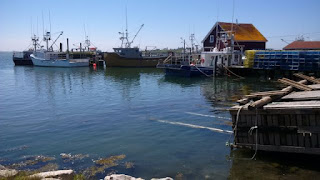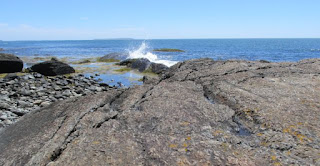
 Under today's blue sky, in a gentle breeze off the sea, we discovered Yarmouth Bar and Pubnico. In our rented Hyundai Accent, we drove along the narrow road to the Cape Forchu lighthouse, passing an interesting looking harbour on the way (John's Cove Wharf). I stopped to take photos of the boats and lobster pots there on our way back along Caie Lane; some of this road is a causeway. The lighthouse is not the original, built in 1839, but a taller 20th century one. A lighthouse keeper's family had lived on the headland for years, keeping farm animals and bees, growing their own vegetables and enduring terrifying storms in the winters. It is dramatically rocky and the views of the inlet and the open sea are wonderful. We watched fishing boats arriving and departing and waves breaking on the rocks, and talked to one of the volunteers presently re-shingling and redecorating the lightkeeper's house.
Under today's blue sky, in a gentle breeze off the sea, we discovered Yarmouth Bar and Pubnico. In our rented Hyundai Accent, we drove along the narrow road to the Cape Forchu lighthouse, passing an interesting looking harbour on the way (John's Cove Wharf). I stopped to take photos of the boats and lobster pots there on our way back along Caie Lane; some of this road is a causeway. The lighthouse is not the original, built in 1839, but a taller 20th century one. A lighthouse keeper's family had lived on the headland for years, keeping farm animals and bees, growing their own vegetables and enduring terrifying storms in the winters. It is dramatically rocky and the views of the inlet and the open sea are wonderful. We watched fishing boats arriving and departing and waves breaking on the rocks, and talked to one of the volunteers presently re-shingling and redecorating the lightkeeper's house.We came back to Yarmouth for lunch at a seafood restaurant; I had far too large a bowl of chowder with haddock and crabmeat floating amongst the copious potatoes, very tasty. Chris had haddock and chips ("Do you want fries with that?").
 In the afternoon we took Highway 103 past Tusket Falls, Belleville and Argyle to West, Middle West and Lower West Pubnico. That strange name is a corruption of the Mi'kmaq name Pogomkook, meaning something like the-place-where-we-fish-for-eels-through-holes-in-the-ice. The first European settlers in Nova Scotia, the Acadians, led in this instance by the Sieur d'Entremont in the 1650s, called the place Pombcoup. Whatever it ought to be called, it is a pretty spot. We found something that wasn't advertised on the tourist map, a new feature right at the end of the Pubnico peninsula: a wind farm managed by NextEra Energy, with 17 enormous wind turbines, some male, some female, according to the engineers who erected them there. Between them, they generate enough electricity for 12,000 homes! It's almost as if the locals are coming full circle. From being an entirely self-sufficient community, raising their own livestock on farmland reclaimed from the salt marshes, fishing, and using their cottage gardens for their needs, they are now self-sufficient in energy.
In the afternoon we took Highway 103 past Tusket Falls, Belleville and Argyle to West, Middle West and Lower West Pubnico. That strange name is a corruption of the Mi'kmaq name Pogomkook, meaning something like the-place-where-we-fish-for-eels-through-holes-in-the-ice. The first European settlers in Nova Scotia, the Acadians, led in this instance by the Sieur d'Entremont in the 1650s, called the place Pombcoup. Whatever it ought to be called, it is a pretty spot. We found something that wasn't advertised on the tourist map, a new feature right at the end of the Pubnico peninsula: a wind farm managed by NextEra Energy, with 17 enormous wind turbines, some male, some female, according to the engineers who erected them there. Between them, they generate enough electricity for 12,000 homes! It's almost as if the locals are coming full circle. From being an entirely self-sufficient community, raising their own livestock on farmland reclaimed from the salt marshes, fishing, and using their cottage gardens for their needs, they are now self-sufficient in energy.We lingered for a long while at the point beyond the turbines (whooshing quietly in the background), sitting on the brand new benches and walking along the new trails along the rocky, marshy shore as well as through the woodland full of wild flowers --- a botanist's paradise --- and butterflies. We saw a large wild rabbit, a hawk and a whole flock of cormorants perching on rock-islands near the shore. The forest consisted of stubby conifers, deformed by the prevailing winds and hung with lichen, and shrubby bushes that I couldn't identify. Some of the flowers were cloudberries.
I insisted we stop at the Dennis Point wharf on the way back through Lower West Pubnico, which was worth it to see the large fleet of colourful working boats moored there, all named after their owners, some in French (e.g. Capitaine Simon), some in English. The Acadian flag was flying everywhere, alongside Canadian flags. We visited a little museum about the Acadian settlers, staffed by two local girls in long Acadian skirts and aprons, one of whom (who told us she had mixed French, English and Mi'kmaq blood) gave us a guided tour of the house, describing the Acadians' turbulent history, despite the fact that they were a peaceable people who wanted to fight neither for the English nor for the French. They were cruelly treated by the British, who banished them and went to the extent of burning their settlements. Some settled in Louisiana where they began to be called Cajuns; they were needed there for their land-reclaiming skills in the marshes. We learned how the aboiteau drainage equipment worked, a salvaged example of this being on show at the museum, quite recently found and recovered from a nearby marsh. They also had a kitchen garden at the back of the museum, planted with exactly the kind of plants that would have been grown here in the 1650s (cabbages, radishes, lovage, Jerusalem artichokes, spinach, carrots, chives, etc. etc.)
Returning to Yarmouth, we took the slower, quieter, less well maintained Route 3 through Lower Argyle, Glenwood and Tusket, round many curves and corners and across wooden bridges over the lakes and rivers, with deep green grass around them and on their islands. It was a lovely ride.
We walked into town in the evening and found a Chinese supper. The tide was right out, leaving parts of the muddy harbour floor exposed and damp seaweed on the harbour walls. We walked along the Maude Lewis trail again, a part of town that the songbirds seem to like as much as we do, where the wild lupins are in full bloom.










No comments:
Post a Comment